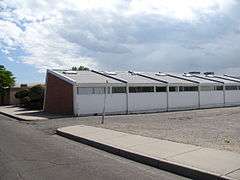Solar Building
|
Solar Building | |
|
Solar Building, May 2010 | |
| Location | 213 Truman St. NE, Albuquerque, New Mexico |
|---|---|
| Coordinates | 35°04′51″N 106°35′16″W / 35.08083°N 106.58778°WCoordinates: 35°04′51″N 106°35′16″W / 35.08083°N 106.58778°W |
| Built | 1956 |
| Architect | Stanley & Wright |
| NRHP Reference # | 89001589[1] |
| NMSRCP # | 1171 |
| Significant dates | |
| Added to NRHP | October 10, 1989 |
| Designated NMSRCP | May 17, 1985[2] |
The Solar Building, located in Albuquerque, New Mexico, was the world's first commercial building to be heated primarily by solar energy.[3] It was built in 1956 to house the engineering firm of Frank Bridgers and Donald Paxton, who were responsible for the heating system design.[4] The novel building received writeups in Life[5] and Popular Mechanics[6] and was the subject of an NSF-funded research project in the 1970s. It was added to the New Mexico State Register of Cultural Properties in 1985[7] and the National Register of Historic Places in 1989.[1]
History
Bridgers and Paxton came up with the idea for an experimental solar-heated building in the early 1950s. After two years of design work, the Solar Building was constructed between March and August 1956 for a cost of $58,500. The heating system operated successfully for six years but was nevertheless converted to a conventional boiler system when the building was expanded in 1962. However, the 1973 oil crisis caused a renewed interest in solar energy and brought fresh attention to the Solar Building. In early 1974, Penn State researcher Stanley Gilman received an NSF grant to restore the building's solar heating system and operate it as part of a multi-year field study.[8] The system was deactivated following the conclusion of the project but remains mostly intact.[9]
Heating system
The building's active solar heating system employed an 800-square-foot (74 m2) collector array on the south wall of the building, which was angled at 30 degrees to the vertical to catch the maximum amount of winter sunlight. Hot water from the collectors fed a 6,000-gallon insulated tank, which provided a reserve for nights and cloudy periods. Under normal conditions the water in the tank would be sufficiently warm to directly heat the building, but if the temperature in the tank dropped (e.g. due to prolonged cloudy weather), a heat pump could be employed to extract the remaining useful heat from the water stream.[8]
Gilman made several modifications to the system in the 1970s, including automating the control system, changing the working fluid in the collector loop to ethylene glycol, and retrofitting the collector panels for better thermal contact.[8]
See also
Notes
- 1 2 National Park Service (2009-03-13). "National Register Information System". National Register of Historic Places. National Park Service.
- ↑ "New Mexico State and National Registers". New Mexico Historic Preservation Commission. Retrieved 2013-03-13.
- ↑ Logan, Paul (March 18, 2005). "Local Engineer Helped Build Solar Office Building". Albuquerque Journal. NM. p. B4.
- ↑ Denzer, Anthony (2013). The Solar House: Pioneering Sustainable Design. Rizzoli. ISBN 978-0847840052.
- ↑ "Warm Winter Behind Glass". Life. 41 (25). December 17, 1956.
- ↑ "Albuquerque Solar Building Tests Radiant-Heat System". Popular Mechanics. 108 (5): 157. November 1957.
- ↑ "Properties by County" (PDF). New Mexico Department of Cultural Affairs. Retrieved 29 April 2011.
- 1 2 3 "Solar Building" (PDF). Retrieved 30 April 2011.
- ↑ "Guidelines for Evaluating and Nominating Properties that Have Achieved Significance Within the Past Fifty Years". National Park Service. Retrieved 1 May 2011.
References
- Gilman, Stanley F. (1979). Evaluation of the solar building, Albuquerque, New Mexico. Final report, April 1974–September 1978 (Report). Pennsylvania State University.
External links
- "Bridgers & Paxton Resources". solarhousehistory.com.
